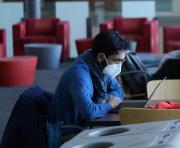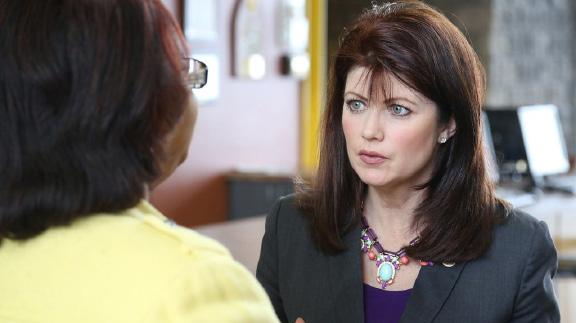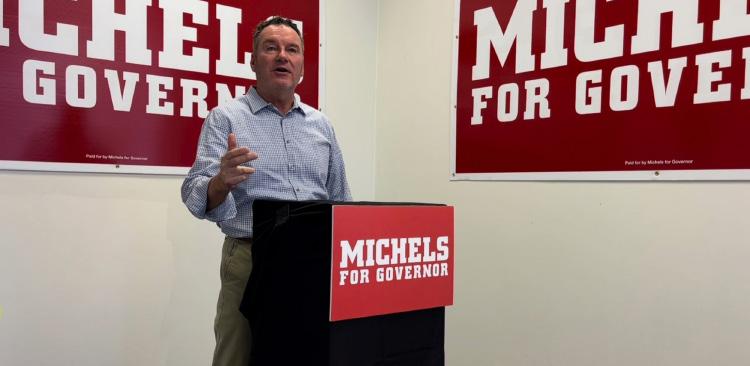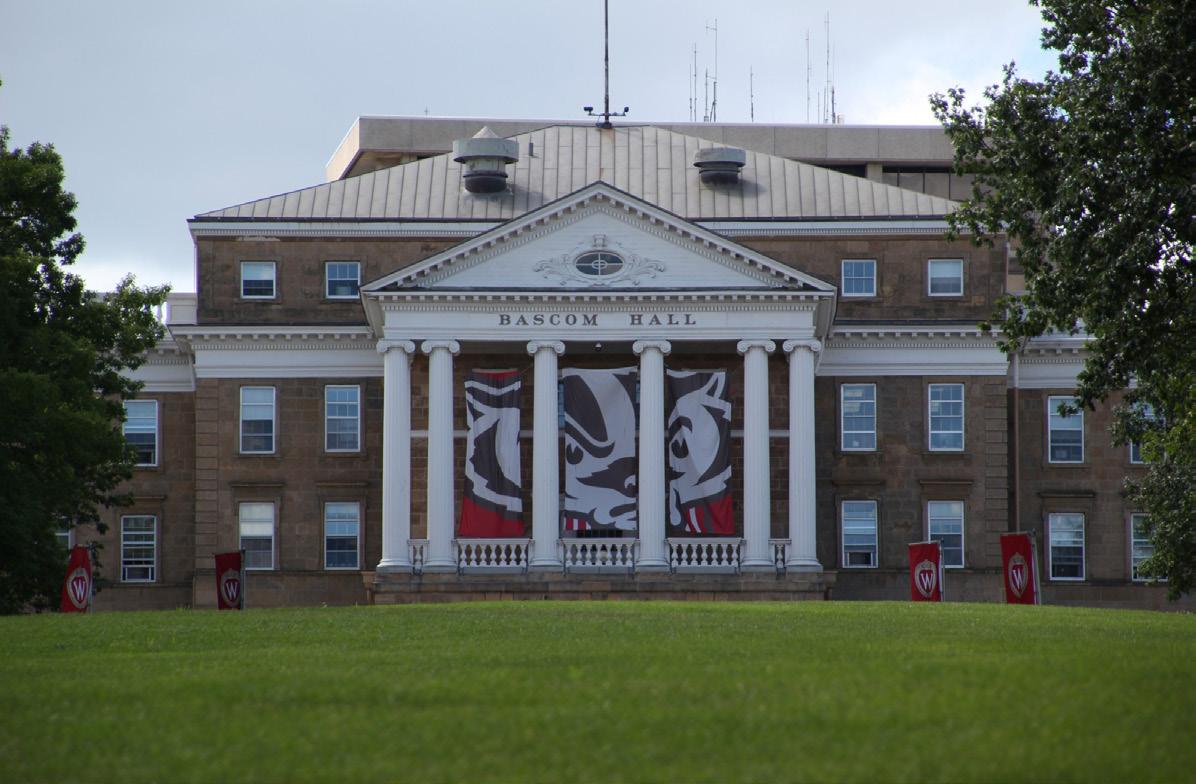





By Claire LaLiberte STAFF WRITER
The Supreme Court’s controversial Dobbs v. Jackson Women’s Health Organization decision, which was released on June 24, has led to vast disparities in reproductive healthcare access between states.
In Wisconsin, the reversal of Roe v. Wade allowed the state’s 173-year-old abortion legislation to be enforced.
Wisconsin’s current abortion legislation comes from an era that had a much less comprehensive understanding of medicine, leaving today’s healthcare practitioners frustrated by unclear language and struggling to apply the law to the modern day.
The 1849 abortion ban includes an exception only in instances during which the mother’s life is at risk. It does not make exceptions for rape or incest. This stands in opposition to the public opinion across the state — a ten-year study by the Marquette University Law School found that roughly 60% of Wisconsinites support abortion access in all or most cases.
Samantha Crowley is a secondyear medical student and the leader of the University of WisconsinMadison chapter of Medical Students for Choice. Her interest in politics and public health led her to pursue a career in family health or obstetrics and gynecology, but she has been left unsure of her field’s future in her home state.
She expressed frustration with the legislation’s archaic understanding of abortion, which does not indicate whether its definition of abortion comprises procedures in cases of ectopic pregnancy or miscarriage.
“Right now, doctors in Wisconsin don’t know if it’s legal to do their jobs, and that’s terrifying,” Crowley said. “In an emergency, doctors should not have to call a lawyer to ask if they are able to save a patient’s life without being charged with a felony.”
Crowley emphasized her belief that any legislation surrounding healthcare and medicine should be written in close consultation with medical professionals. In failing to do so, legislators risk ambiguities and inconsistencies that can have profound consequences.
Despite being a native Wisconsinite, Crowley expressed reservations about providing reproductive healthcare in the state so long as these laws remain in place. She said a healthcare
practitioner wants to work in a place that “provides support for evidence-based treatment,” but Wisconsin’s new restrictions detract from that.
A junior pre-medical student who chose to remain anonymous scorned the fact that these laws take healthcare decisions out of doctors’ hands. He believes that providers being unable to make final decisions on healthcare will “erode the relationship and trust between people and medicine, particularly underserved groups.”
A dearth of available care, particularly in reproductive health, is a problem that existed in Wisconsin long before the Dobbs decision. According to Crowley, “the [reproductive health] landscape in
Wisconsin was already bad — there were only four abortion clinics in the state.”
Healthcare inequity is also prevalent in Wisconsin. The state has the nation’s worst record for Black infant mortality, and Black individuals die in childbirth at a rate five times higher than white Wisconsinites.
Sophia Vrba, the president of UW Medical School’s Medical Students Association, is currently in her second year of UW’s MD-PhD program. She is studying to become an OB-GYN, driven by a desire to advocate for patients, and she emphasized the disproportionate impact this decision is sure to have on disadvantaged communities.
Vrba noted that while those with the means to cross state lines will seek abortions in Minnesota or Illinois, groups already su ering from a lack of healthcare access will face much greater “barriers to travel.”
A second-year medical student who chose to remain anonymous expressed concern about what these policies mean for the future of the UW Medical School. If an individual wants to practice as an OB-GYN, she explained, they would be reluctant to attend a school in a state where they would not be able to train and learn about certain procedures.
She also stated that UW Medical School is supposedly denying academic credit and malpractice insurance to students seeking externships in less
restrictive states so that they can learn procedures such as abortion.
The school’s administration seems reluctant to outline its policy on what training will be provided in these fields, and this was likely because the administration knew it would decrease interest in the program, according to the student.
Gwen McIntosh, the University of Wisconsin School of Medicine and Public Health Associate Dean for Students, said medical students receive didactic training in the full range of reproductive care. However, UWSMPH does not permit medical students to participate in hands-on training for pregnacy termination or abortion due to Wisconsin State Law Wis. Stat. 940.04.
Crowley added that even if the Dobbs decision were to be reversed in the future, Wisconsin would still find itself with a huge number of healthcare practitioners who had not trained in reproductive care procedures, one of many ways in which these laws could have implications far beyond the immediate future.
As healthcare practitioners and legal professionals alike attempt to navigate the suddenly murky landscape of Wisconsin reproductive healthcare, medical students are facing uncertainty and frustration. However, for those who seek to improve Wisconsinites’ quality of life and access to resources, it represents a new set of challenges for providers and patients.

By Gavin Escott STAFF WRITER
Summer isn’t the only thing heating up in Wisconsin — it’s election season.
On Aug. 9, Wisconsin will hold primaries for an array of statewide o ces to determine candidates for the general election in November. The State Assembly and State Senate are both on the ballot.
This November, the entire lower house of the state legislature is up for election. The 99-seat Assembly is currently dominated by Republicans, holding 57 seats to the Democrats’ 38 seats. There are four vacancies.
District 76, which comprises the entire Madison isthmus and parts of the University of WisconsinMadison campus, is represented in the assembly by Francesca Hong. A
first-term Democrat, Hong has served since January 2021. She made progressive policies a cornerstone of her time in o ce, signing on to e orts to achieve environmental, racial and economic justice.
“We’ve pushed for an LGBTQIA+ task force, [and] introduced over 22 climate justice bills,” Hong said in a campaign video. “We fought for eviction prevention [and] livable wages.”
Hong, a longtime advocate for reproductive health and access to
abortion, has also signed onto the Economic Justice Bill of Rights, which would ensure every Wisconsinite has the right to a union, collective bargaining, a ordable childcare and safe housing, among other policies. Acting as a framework for future legislation, the joint resolution remains unadopted in the face of Republican opposition in the Assembly.
“While my Democratic colleagues and I have been working hard for Wisconsinites, our Republican opponents continue to obstruct. They continue to refuse to govern,” Hong said, adding that she and fellow Democrats will continue to fight.
Hong is running unopposed.
District 77 — covering Madison’s West Side and the main body of the UW flagship campus — is represented by Sheila Stubbs, a Democrat who assumed o ce in 2019. Stubbs’ main priorities are increasing funding for K-12 education as well as the UW system, reforming Wisconsin’s criminal justice system and advocating for reproductive justice. Other priorities include increasing access to healthcare for all, reducing gun violence, strengthening the social safety net for disabled, senior and adolescent constituents and protecting Wisconsin’s clean air and water.
Stubbs is running uncontested
By Ellie Bourdo ASSOCIATE NEWS EDITOR
The University of WisconsinMadison responded with recommendations from health o cials from the Public Health Madison and Dane County (PHMDC) as the Centers for Disease Control and Prevention (CDC) declared Dane County a “high” community level of transmission as of July 21. This is because of an increase in hospitalizations and confirmed cases around the county.
The CDC found a case rate of 310.59 per 100,000 people in Dane County. They also found 4.8% of sta ed inpatient beds are currently occupied by patients confirmed to have COVID-19.
Currently, 91.7% of Dane County residents have at least one dose of the vaccine, while 83.8% have been fully vaccinated, the CDC reported.
PHMDC health o cials encourage students and sta to wear masks in indoor public spaces, specifically N95s or KN95s, which provide the greatest amount of protection — regardless of vaccination status. They also recommend staying up to date on vaccinations, including booster shots.
“We’re seeing this trend of communities moving to medium and high levels nationwide, and it is possible we could bounce between medium and high levels for a few weeks,” PHMDC director Janel Heinrich said in a release. “Being aware of our local landscape — especially if you are immunocompromised or at risk of severe illness — and taking appropriate actions can help prevent the spread of the virus.”
With a “high” community level of transmission in Dane County, the CDC o ered several recommendations, especially for those who are
as well.
Lisa Subeck, who represents District 78, which spans Madison’s southwest side, is running for reelection as well. Having served in the assembly since 2015, Subeck currently sits on multiple Assembly committees, including the Committee on Health and the Committee on Campaigns and Elections.
Subeck has been outspoken in her support of a woman’s right to choose and introduced a bill to repeal Wisconsin’s 1849 criminal abortion statute. She also introduced legislation that would prohibit gun ownership for those convicted of misdemeanor domestic violence, which would be enforceable at the state level.
Subeck is running unopposed in the Democratic primary but will face Matt Neuhaus, a Republican, in the general election.
Dianne Hesselbein, the District 79 representative since 2013, has chosen to run for State Senate, leaving her seat in the State Assembly open. Those vying for the seat are Democrats Alex Joers and Brad Votava, as well as a Republican, Victoria Fueger. District 79 covers Middleton and Lake Mendota’s surrounding areas.
Alex Joers, a member of the Dane County Board of Supervisors, has made economic security, envi-
ronmental sustainability and health equity central points of his campaign. During his time on the Board of Supervisors, Joers served on the Public Protection and Judiciary Committee, UW Extension Committee and Youth Commission.
According to Joers’ campaign, he elevated issues of land conservation, flood mitigation, small business recovery, public health and a ordable housing — proposals he wants to advance at the state level if elected.
Brad Votava is a former entrepreneur who founded Archer Geographic, a mapping service that collaborates with public and private partners to solve complex land and water issues. Votava pledged to expand voting rights and access to voting for all, calling for a nonpartisan redistricting process that would address Wisconsin’s extreme gerrymandering, among the worst in the country.
“I believe this moment calls for new voices, new leadership and a diverse group of citizens committed to public service to center on the voices of the people of our state over special interests and work towards shared solutions to our common problems,” Votava said. “As our representative to the State Assembly, I aim to listen intently to the people of our district.”
Aug. 9 will be the first statewide election with Wisconsin’s new legislative maps in place. The maps, created by Senate Majority Leader Devin LeMahieu (R) and Assembly Speaker Robin Vos (R), were adopted on April 15 after a fierce partisan struggle that saw Gov. Tony Evers (D) veto the maps and propose his own, which would have reduced state Republicans’ entrenched advantages. This map was approved in early March.
However, that map was rejected by the U.S. Supreme Court a few weeks later, which ruled that Evers’ map failed to follow established precedent for whether the Voting Rights Act should apply. Due to “time and institutional limitations” which made constructing a new map “unrealistic,” swing Justice Brian Hagedorn, who previously sided with the court’s liberals in selecting Evers’ map, instead sided with his conservative colleagues in choosing the earlier proposals from Lemahieu and Vos. These maps bolster Republicans’ advantages and solidify already Republicanfavored districts.
Wisconsin has an open primary system, which means registered voters do not have to be members of a party to vote in that party’s primary.
By Madeleine Afonso STAFF WRITER
immunocompromised or at high risk for severe disease. Guidance includes wearing a mask, avoiding non-essential indoor public activities and speaking with a healthcare provider.
Students and sta are encouraged to stay home and get tested when feeling sick, UW-Madison said in a July 21 statement. The university is o ering COVID-19 vaccinations along with PCR testing by appointment at no cost. Students can make appointments through MyUHS.
The university is continuing the policies currently in place for students and sta who test positive for COVID-19 until further notice.
Individuals must isolate for at least five days upon testing positive and may only leave isolation if they have gone at least 24 hours without a fever and if other symptoms go away, according to University Health Services at UW-Madison.
Students who test positive for COVID-19 in residence halls will be provided an isolation space.
Currently, UW-Madison has made no changes to campus operations this summer or fall. Students and sta are still not required to wear masks in classrooms. Events and gatherings a liated or sponsored by the university are also not subject to any COVID19 restrictions as of March 12.

On the heels of the Supreme Court decision to overturn Roe v. Wade, eliminating the constitutional right to an abortion, demand for more abortion care services has grown among university students across the country.
Access to abortion medication at university health service centers has been one of the biggest demands. Medication abortion is different from the more widely available morning-after pill, which is taken to block a pregnancy. The abortion pill includes taking one mifepristone pill, followed by one or multiple rounds of misoprostol pills during the first 10-12 weeks of gestation to terminate a pregnancy.
Some colleges have, or plan to make, abortion medication available, including the University of Illinois Chicago and University of Massachusetts Amherst. University of California and California State University schools will be required to provide the pills at campus medical centers starting Jan. 1, 2023, according to the LA Times article.
However, the University of Wisconsin-Madison is unlikely to follow. As of now, University Health Services (UHS) on campus does not provide abortion medication.
“[Abortion medication] care falls outside the scope of our services. This is not affected by the recent Supreme Court decision,” UHS health communications strategist Sarah Clifford said.
Currently in Wisconsin, abortion access is virtually ille-
gal as the state reverted to an 1849 law that banned clinical practice from medical providers. All four clinics in the state have halted procedures.
In response, Wisconsin Attorney General Josh Kaul filed a lawsuit in an attempt to block this resurfaced ban. Although, if the ban were to be enforced, it would apply to medication abortion.
Publicly funded universities and those in states with restrictive abortion bans face legal barriers and hesitation to supply medication abortion, as laws and policy surrounding abortion continue to be in flux.
“[We] provide healthcare within the boundaries and requirements of state and federal law,” Clifford emphasized.
UHS provides abortion counseling and information about abortion medication to patients seeking health care resources.
Despite limited abortionrelated care, UHS provides extensive contraception services to students. These include telehealth contraception consultations where students can be prescribed the appropriate contraceptive method over the phone with a provider and three types of emergency contraception — IUD insertions, levonorgestrel pills (Plan B) and ulipristal acetate tablets (Ella).
Samantha Herdon, communications manager at the Collaboration for Reproductive Equity (CORE) at UW-Madison, explained medical abortion has been approved by the Food and Drug Administration since 2000.
“Aid Access, Hey Jane and Plan C pills are some of the providers that CORE’s research shows are used by Wisconsinites

to access medication abortion,” she said.
CORE conducts and translates interdisciplinary research on reproductive healthcare and policy in Wisconsin, including information on reproductive services like medical abortion.
Abortion medication is proven to be both safe and effective, and makes up over half of all abortions in the U.S.
“Our research shows that [Wisconsinites] who need clinical care may travel to Illinois, Minnesota or other states to access abortion care,” Herdon said.
“However, some people cannot a ord to go out of state, which can be very expensive with travel costs, overnight stays, childcare and other costs factored in,” she continued.
Medication abortion is considered self-managed, as it is obtained outside the formal healthcare system — which is still legal, per Wisconsin state law.
By Ian Wilder STAFF WRITER
Election information for UW-Madison students is available at vote.wisc.edu. For more information on ballots, registration or pollingsitesfortheAug.6partisanprimary, visit www.myvote.wi.com.
Wisconsin Republican Governor candidates Tim Michels and former Lt. Gov. Rebecca Kleefisch are in a dead heat with less than two weeks before the August primary election.
The latest Marquette Law School poll from June shows Michels (27%) ahead of Kleefisch by a single percentage point. Kevin Nicholson, who suspended
Thompson. Kleefisch is endorsed by former Vice President Mike Pence, Sen. Ted Cruz (R-Texas), Assembly Speaker Robin Vos (RRochester) and former Gov. Scott Walker, among others.
The winner of next Tuesday’s primary will challenge Democratic Gov. Tony Evers in November. Despite President Joe Biden’s popularity hitting all-time lows in July, Evers remains above water with 48% approval in the latest Marquette Law School poll.
If Democrats lose the seat, Republicans will control the Assembly, Senate and Governor’s o ce. A GOP trifecta would allow Republicans to enact bills previously blocked by Gov. Evers,

his campaign in July, was third with 10% and state Rep. Timothy Ramthun (R–Campbellsport) was fourth with 3% support. An additional 32% said they “didn’t know” who they planned to vote for.
Michels proudly carries the endorsements of former President Donald Trump and former Wisconsin Governor Tommy
such as racial education restricitons, harsher abortion laws and restrictions on gender identity and expression in schools.
Options to register online or by mail for the Aug. 9 primary election have passed. However, voters can still register at their municipal clerk’s o ce by Aug. 5 or register the day of the election at their poll-
ing place with a valid photo ID and proof of Wisconsin residence.
Meet the candidates
Michels, who co-owns Brownsville-based construction giant Michels Corporation, has run for political o ce twice before. He first ran in 1998 when he lost a State Senate Republican primary. In 2004, he won the Republican nomination for U.S. Senate before losing the race to former Democratic Sen. Russ Feingold.
Still, Michels says he’s “not looking for a political career.”
“I’m 59 years old. I am doing this to serve,” Michels told WPR in late July. “President Trump didn’t have to run for president, but he wanted to drain the swamp. I don’t have to run for governor, but I’m gonna go turn Madison upside down.”
Michels’ campaign has dominated fundraising, raising nearly $8 million to Kleefisch’s $3.7 million, according to campaign finance records. Over 99% of Michels’ campaign haul was self-funded.
His platform centers around increasing police resources, lowering taxes and expanding vocational training. Michels also supports Wisconsin’s 1849 abortion ban, which makes no exceptions for cases of rape and incest.
The previously dormant ban was reinstated following the U.S. Supreme Court’s ruling in Dobbs v. Jackson Women’s Health Organization last June. The 6-3 ruling e ectively dismantled Roe v. Wade, which had previously guaranteed the right to an abortion.

Supreme Court Justice Clarence Thomas wrote a concurring Dobbs opinion that called for reconsideration of other cases that guaranteed the right to same-sex marriage, among others. Michels openly opposes same sex marriage.
Kleefisch’s campaign has centered around her previous work as Lieutenant Governor under former Gov. Scott Walker. She also promised voters new tax reforms, including a clear plan for a flatter income tax as a first step to completely removing individual income taxes.
Although the federal income tax would remain, this plan would largely benefit the wealthiest Wisconsinites and reduce the state’s budget for infrastructure, education and other vital public services, according to an analysis from the Wisconsin Budget Project.
Kleefisch admitted her plan would require “some sacrifices,” but said she’s committed to moving or cutting state agencies to lower taxes, according to the Cap Times.
In July, Kleefisch, Michels and Rep. Ramthun met face-toface for a debate. Each candidate was asked whether they would attempt to decertify Wisconsin’s 2020 election results despite such a task being impossible.
Michels called decertification “not a priority,” despite being endorsed by former President Trump, who continues to demand Wisconsin Republicans decertify the 2020 election results. Kleefisch similarly stated that she would not aim to decertify the election results.
Ramthun, whose campaign is largely centered around decertification, was the only candidate who said he would attempt to decertify the election.
“I’m surprised I’m the only one,” Ramthun added.
All three candidates, however, support dismantling the Wisconsin Election Commission. The commission was established by Republicans in 2015 but has been criticized by GOP o cials in the wake of the 2020 election.
By Annabella Rosciglione
FEATURES EDITOR
Ten Republican senators would need to back the Respect for Marriage Act for it to pass in the U.S. Senate. Sen. Tammy Baldwin (D-Wis.) is the leading Democrat attempting to get Republican senators to back the bill which would codify same-sex and interracial marriage if passed.
“Americans overwhelmingly support the constitutional right to marry who they love without interference from politicians or the government,” Baldwin’s o ce said in a statement to the Daily Cardinal. “I introduced bipartisan legislation that would enshrine and protect marriage equality and make sure legal same-sex and interracial marriages are recognized because we cannot allow this freedom and right to be denied.”
Sen. Baldwin is the first openly gay senator — ever.
The Respect for Marriage Act would federally recognize all marriages across state lines by overturning the Clinton-era Defense of Marriage Act. This 1996 law defines marriage — under law — as between one man and one woman, allowing states to not recognize same-sex marriages.
The 2015 U.S. Supreme Court case Obergefell v. Hodges made this portion of the Defense of Marriage Act unenforceable. However, the law will stay in place should Obergefell v. Hodges be overturned, as conservative Justice Clarence Thomas expressed interest in revisiting this case.
“I had not expected to be fighting to protect a right that’s already been won in court,” Baldwin said in late July to POLITICO.
Justice Thomas, in a concurring opinion fol-
lowing the 6-3 passage of Dobbs v. Jackson, which e ectively repealed the 1973 landmark abortion case Roe v. Wade, wrote “in future cases, we should reconsider all of this Court’s substantive due process precedents, including Griswold, Lawrence and Obergefell.”
Griswold v. Connecticut (1965) ensures the constitutional right for married couples to access contraception without government intervention, while Lawrence v. Texas (2003) states same-sex sexual activity is constitutional.
In dissent to Dobbs v. Jackson, Supreme Court Justices Elena Kagan, Stephen Breyer and Sonia Sotomayor said “it breaches a core ruleof-law principle, designed to promote constancy in the law.”
“It places in jeopardy other rights, from contraception to same-sex intimacy and marriage,” the Supreme Court Justices noted.
Baldwin held one-on-one conversations with her Republican colleagues about the Respect for Marriage Act. Additionally, members of Baldwin’s sta have been meeting with those of her Republican counterparts.
Ultimately, Baldwin believes these discussions are working.
“They’re going well. And I feel hopeful and I have to make some more calls,” said Baldwin. “I am talking to a lot of folks, but folks who I think want to get to yes.”
Sens. Susan Collins (R-Maine) and Rob Portman (R-Ohio) are co-sponsors of this bill with Baldwin. Forty-seven U.S. House Republicans, including Wisconsin’s U.S. Rep. Bryan Steil, voted for the bill’s passage in the house.
So far, five Republican senators have publicly backed the bill. Baldwin claims she is very close to reaching her goal of 10, with some Republican senators privately indicating their support.
“We’re very close to 10, which is what we need to overcome a filibuster in the Senate. But I think I will keep on going beyond 10, just as extra insurance,” Baldwin told The 19th News.
Sen. Ron Johnson (R-Wis.) publicly said he would support the bill, though he claims the bill is unnecessary.
“Unlike Roe v. Wade, I do not see any scenario in which the Supreme Court would overturn Obergefell,” Johnson said. “The Respect for Marriage Act is another example of Democrats creating a state of fear over an issue in order to further divide Americans for their political benefit. Even though I feel the Respect for Marriage Act is unnecessary, should it come before the Senate, I see no reason to oppose it.”
Other Wisconsin legislators find reason for why this bill is necessary through Thomas’ interest in revisiting Obergefell v. Hodges.
“This bill is very necessary,” U.S. Rep. Mark Pocan of Wisconsin said in an interview with The Milwaukee Journal Sentinel. “Because the extremist-packed Supreme Court recently took away a half-century of law on Roe and in that decision Justice Clarence Thomas said they should revisit marriage equality.”
In Wisconsin, 58% of adults support samesex marriage according to polling from the Pew Research Center. Nationally, 71% of Americans support same sex marriage as per a Gallup poll conducted in May.
Rep. Pocan reiterated his support for the bill, highlighting his marriage to Philip Frank.
“I want to make sure my husband, Phil, can visit me in the hospital should I have to go back again, like when I had triple bypass a few years ago,” Pocan said. “I want to make sure my husband has my earned benefits for retirement and social security. I want to make sure that my husband is taken care of just like your spouses are taken care of.”


By Donnie Slusher SPORTS EDITOR
In case you missed it, the Big Ten grew.
On June 30, the Big Ten announced USC and UCLA would join the conference starting in 2024.
The move was met with shock from all corners of the college sports world.
Realignment isn’t a new concept in college sports. Just last year, Oklahoma and Texas accepted an invitation to join the SEC in 2025. But the nature of this move felt different than the conference shake-ups in recent memory.
Nobody ever imagined a world in which Los Angeles schools would join the Big Ten. Teams on the West Coast have always played other teams on the West Coast. Teams in the Midwest play other Midwest teams. This world is no more.
“I wasn’t going to come into [this job] saying, ‘Oh, well, this is the way it’s been,’” Big Ten commissioner Kevin Warren said regarding the USC/UCLA announcement. “The organizations, the entities and the people who are going to be able to thrive in a disruptive environment are those who embrace being comfortable in an uncomfortable situation.
“The organizations or con-
ferences that are going to come out of this in a really good position are those that are able to adapt and be nimble,” Warren continued.
The chaos isn’t stopping, either. It will likely accelerate — sooner rather than later.
Luckily for Big Ten schools, the conference seems to be in a position of power. On top of expanding westward, they’re on the cusp of an alleged $1 billion contract with Fox.
Realignment is never certain, or even predictable. The USC/UCLA news came out of nowhere. Regardless of what Big Ten suits reveal to the public, they have their eyes set on their next target(s).
“It will be done for the right reasons at the right time with our student-athletes, academic and athletic empowerment at the center of any and all decisions that we will make regarding any further expansions,” Warren said about potential realignment. “We will not expand just to expand.”
Now, the question is, who fits the Big Ten criteria?
Notre Dame
Let’s stop beating around the bush. Notre Dame belongs in the Big Ten.
The Fighting Irish are one of the biggest brands in all of
college sports. Yet in football, they’re independent. All of Notre Dame’s sports — except football — belong to the ACC. Their football team even joined the conference during the shortened 2020 season.
But, Notre Dame is too good of a program to invest in a conference that isn’t the Big Ten or SEC.
The Fighting Irish have remained tight-lipped amid the realignment chaos. Yet CBS Sports’ Dennis Dodd recently reported that the Irish are looking for $75 million annually from their broadcasting partner NBC to remain independent. Notre Dame currently earns $22 million annually from their contract. NBC is only willing to o er the significant raise if the Irish seek “shoulder programming” from a major conference.
It wouldn’t be nearly the same as becoming a member, but could indicate the beginning of a future partnership. Regardless, the Big Ten should show maximum interest in any sort of relationship with the Irish.
The Big Ten’s academic reputation was an important factor in USC and UCLA’s decision to join the conference. Notre Dame likely shares these values, given their supreme academic standing.
Ultimately, the move makes
sense. Indiana is already home to two other Big Ten universities. Along with Michigan, the Big Ten will be home to two of Notre Dame’s biggest rivals after USC arrives in 2024.
Many Irish decision-makers and fans take pride in their independent status. If Notre Dame can continue to contend for the college football playo and remain financially viable, they’ll see no reason to scramble and join a conference. Yet if the Big Ten and SEC become too rich and powerful, Notre Dame could fall behind and become desperate for a bigger paycheck.
Oregon, Washington
The Pac-12 is in a rough period. They lost two of their biggest brands: USC and UCLA. There’s been talks of a merger with the Big 12, although those rumors will reportedly not materialize.
Of the remaining Pac12 schools, the University of Oregon and University of Washington are perhaps the two biggest targets.
Sports Illustrated’s Pat Forde ranked all Power Five schools based on “desirability” — a mixture of sports and academic rankings, viewership, revenue and more. Of the remaining Pac12 teams — not counting USC and UCLA — Washington finished
highest, ranked at 15. Oregon was ranked 22, third in the Pac-12. Oregon and Washington are recognizable brands with passionate fanbases, as both finished within the top 20 in the viewership metric. Perhaps most importantly for realignment, they were ranked as top 25 football programs. These are consistent football programs that will create attractive matchups with other Big Ten schools — garnering higher ratings and revenue. This move makes sense for both sides. Washington and Oregon can invest in a true powerhouse conference instead of sinking with the ship that is the Pac-12. The Big Ten can expand their breadth of influence even wider. A primarily Midwest conference could come to dominate the West Coast.
Dennis Dodd of CBS Sports reported that the Big Ten is additionally considering the University of California-Berkeley and Stanford University as potential members. While both are viable academically, their football programs have underachieved in recent years and may not be as attractive to television networks. The Big Ten will likely prioritize Oregon and Washington.

By Ethan Wollins OPINION EDITOR
The fact that the drinking age is 21 years old in the United States has always bothered me. The reasoning for this arbitrary number of birthdays has never made logical sense, as many underage University of WisconsinMadison students, Wisconsin residents and other college students indulge early in their non-sober lives.
Let us be realistic for a moment. Is anyone truly convinced that a majority of American teenagers are law-abiding citizens of the United States and wait until 21 years of age to take their first sips of alcohol? I seem to think not. However, there are many scenarios and explanations as to why these teenagers choose to drink or remain sober until they are out of their parents’ houses.
Many parents in religious households, predominantly Protestant Christians as well as Muslims, are sober because of reasons in their respective religious scriptures.
Ephesians 5:18 strikes down on any level of “drunkness” portrayed by a member of the church, but does not explicitly prohibit the consumption of alcohol. Yet, many members of the faith infer this sentiment as a call to prohibitionism, whereas alcohol will inherently incur a sense of “drunkness.” For Muslims, this is far more restricted, with alcohol being explicitly forbidden in the Quran because of the e ects it has on the body and mind.
Logically, if the parents of a household are sober for religious reasons, or for moral reasons, their children are likely to abide by similar principles while living at home. This also means these children are usually not exposed
to drinking in any form during their adolescence, thus creating a lack of education about how to drink alcohol later on in their lives.
This does not mean these teens will necessarily feel so inclined to drink alcohol the moment they leave their childhood households. However, the freedom associated with this nuanced adulthood can bring uneducated decisions about their consumption.
Education surrounding the consumption of alcohol is extremely important for adolescents around the world – regardless of how mundane it may seem. Yet, who is left to teach them if parents choose to not expose their children to these lessons? Rather than having access to necessary education about how to enjoy alcohol safely, many young Americans are left stranded.
Across the Atlantic, Europeans are doing a far better job educating their youth about safe consumption practices. France has been anecdotally known for its great acceptance of alcohol through the rich culture of French wine.
When I visited my Frenchexchange student in Reims, about 90 minutes Northeast of Paris, his parents supplied a mere fluid ounce of wine for us to enjoy with our lunch. This is somewhat customary, as this amount of wine is not enough for individuals to feel any level of intoxication but instead allows for French teens to grow accustomed to the national wine culture.
Since the French youth are usually exposed to alcohol at earlier ages than their American counterparts, they better understand risks associ-
ated with the poisonous drink and learn to manage their alcohol without parental supervision.
In fact, 2015 data showed France had less alcohol-related car deaths than the US. With the lowered drinking age to 18, the French are able to educate their youth about drinking
can determine when their children are mature enough to learn about alcohol, instead of leaving the choice to restrict consumption until 21 years old up to the government.
Why 21 years old?
Regulation in America and other countries around the world makes

and driving early, thus causing a nationally lower number of alcoholrelated car deaths.
American teenagers who lack this prior exposure in the U.S. are thrown into the binge-drinking communities of many American universities and are forced to quickly learn how to manage their alcohol on their own.
Yet, some states have taken steps that allow parents to choose when and how they educate their children about alcohol. Wisconsin state law allows the consumption of alcohol by anyone under the age of 21 if a parent or guardian is present, making this a private decision. Parents
complete sense. A minimum age of 18 to legally enjoy an alcoholic beverage is necessary for the safety of our communities. But, how much of this regulation should be allowed, and who should make the decision to regulate?
Before 1984, the federal drinking age in America was 18 years old. The National Minimum Drinking Age Act of 1984 o cially changed the federal age to 21 years old, but the reasons for this modification were quite ba ing. Forgoing the science that may be involved, a classic political trade-o was the major reason in getting this bill passed. The federal government
threatened to withhold highway funding if states did not raise their drinking age. The result? Every state changed their laws to receive this federal funding.
After this law was passed, the classic sound bite surrounding the high drinking age was introduced to American media. The, “why should we be allowed to serve in the military, possibly giving the ultimate sacrifice, but not legally be allowed to enjoy a beer?” has exponentially gained attraction with many journalists. While this sound bite is completely correct in that this law is extremely illogical, concrete steps must be taken to revert the drinking age back to 18.
However, moving toward this change would be extremely di cult. Lowering the drinking age lacks importance relative to other issues plaguing our nation. Similarly, a change to this law would barely matter for the constituents of these elected o cials. Since only a small portion of these constituents would fall in the three year lame-duck ages of not being able to legally indulge from 18-21, why would other of-age constituents even care about this issue?
Widespread underage drinking on American college campuses should signal that the enforcement of these state and federal laws do little to nothing to prevent underage consumption. Would a college student really be dissuaded from drinking again if they got a couplehundred-dollar drinking ticket? If these prosecutions are doing nothing, why even prosecute?
Read more @dailycardinal.com
By Lily Ernandez STAFF WRITER
With out-of-state tuition prices rising 8% each year, the average college student who chooses to attend an out of state university graduates with over $30,000 in loan debt. At the University of WisconsinMadison, an out-of-state student will pay upwards of $216,000 for a four year undergraduate degree. Even with this hefty price tag, there are few career areas that offer a quick return on investment.
Northwestern University boosts the highest tuition for a Big Ten school, but that is largely due to the fact that the school is private. The highest out-of-state tuition rate for a public Big Ten school belongs to the University of Michigan at $72,127 per year. In terms of debt, a student looking to attend the University of Michigan from out-of-state would graduate with a much more daunting student loan debt total.
Simply put, Midwestern residents looking to attend neighboring states’ universities are suffering at the expense of outof-state tuition — even if they live only a few hours away from the school.
On the surface, university executives could use the guidelines of the Big Ten athletic conference to give in-state tuition reciprocity. Given that all current members of the Big Ten
conference are “state-schools,” or public universities, this idea would allow all residents of these states to attend other Big Ten member schools at an instate tuition rate.
This reciprocity system is already the case at some Big Ten schools. Minnesota and Wisconsin already have tuition reciprocity set up for their residents where students from either state can attend each other’s out of state university at an extremely discounted rate. Although, this in-state tuition reciprocity may not be a reasonable solution for all Big Ten schools.
Many Big Ten schools are concerned about reduced tuition prices taking away funding. While this is a legitimate concern, the truth is that a school’s budget is not solely comprised of tuition revenue.
For example, the UW-Madison 2019-20 fiscal year budget shows that tuition revenue made up only 20% of the total. Reducing the cost of tuition would only affect a small portion of the total budget, and revenue would not be eliminated completely. With more money in students’ pockets because of lower tuition costs, they might be more willing and able to spend their money on other components of the budget, such as Intercollegiate Athletics.
Instead of full tuition reciprocity for all Big Ten schools,
programs like the Midwest Student Exchange Program (MSEP) exist to give students the option to not pay as much tuition at neighboring state schools. The program contains a group of Midwestern schools that agree to not charge an out-of-state student more than 150% of the in-state tuition. Most of these schools are from Midwestern states and have NCAA Division II and III athletic programs, with a few maintaining Division I status.
While other athletic conferences have many schools that are included in the MSEP, the MSEP philosophy should be reinstated with every state that has a school in the Big Ten. This would allow for more Midwestern students to inexpensively attend outof-state schools. However, all states must agree to follow these tuition rules to make this philosophy effective.
States like Illinois that have above average in-state tuition costs will be incentivized to lower their in-state tuition to keep more students in the state.
Although, this could dramatically reduce the revenue generated from high out-ofstate tuition.
To balance this decrease in revenue, albeit a mere fraction of the budget, students from outside of the MSEP range will still have to pay normal, out-ofstate tuition rates.

Specifically for UW-Madison, merit-based scholarships are not offered to out-of-state students. At this rate, non-Wisconsinite students are almost guaranteed to pay the full price of $54,000, regardless of any academic achievements.
By including Big Ten schools in the MSEP, universities will attract more Midwestern outof-state students who cannot justify paying over $50,000 to study one or two states away from their resident states.
In fact, evidence has already shown results from lowering out-of-state tuition. In the 202122 academic year, only 35% of UW-Madison enrollment came from outside Wisconsin.
Meanwhile, the University of Iowa boasts a lucrative outof-state scholarship program that lowers tuition and brings
in 42% out-of-state students to their institution.
Ultimately, Big Ten schools need to join the smaller schools in the MSEP to lower tuition costs for local Midwest students who seek a larger school experience.
By allowing out-of-state Midwestern students more freedom and affordability when leaving their home states for school, we can lower student loan debt and allow students to choose schools without the high cost of tuition weighing on the decision.
Lily Ernandez is a freshman studying Neurobiology and Global Health. Do you believe that all midwestern students should receive reduced out-ofstate tuition at Big Ten schools? Send all comments to opinion@ dailycardinal.com
By Samantha Benish SENIOR STAFF WRITER
The University of Wisconsin-Madison is known for a lot of things: rigorous academics, memorable traditions, exciting athletics and stunning views. Despite all of these impressive attributes, I consider the students here to be the most valuable assets to UW’s name. I’ve met many individuals in my three years here.
Every single one of them are dedicated, hard-working and driven. It’s impossible to not compare your professional life to the incredible people that you meet, and it’s something that I’ve struggled with as I’ve found my college identity.
To date, I’ve had seven professional internships while attending UW. Each one provided an experience to grow in both my major and industry. I’ve learned valuable insight into what I like doing and what bores me. They have been invaluable in helping me determine what I want to do once I graduate in a few short months.
But this isn’t an ad to encourage you to apply for the next internship you see – I’m here to tell you that not
everything is what it seems.
Internships vary in a variety of ways, including how much time and dedication is needed to fulfill them. In the spring of 2022, I worked a semester-long internship at a local business in Madison. I was required to work a minimum of 27 hours a week – Wednesdays, Saturdays and Sundays with an exception of one day off every other weekend. Let me tell you, it was as difficult as it sounds.
However, from an outside perspective, nobody saw how much I was struggling. All they saw was how exciting my internship was and what I was doing. No one was there to tell me how “cool it was” when I was up until 2 a.m. finishing my homework after finishing a ten hour shift.
No one congratulated me on missing out on a friend’s birthday because I had to work. No one sympathized with me when I told them I couldn’t go out to the bars because I had to be up at 7:30 a.m. the next day.
Don’t get me wrong – that internship was crucial in furthering my future career and figuring out what I even want to do.
Yet, it was the hardest thing I’ve ever had to take on, and nobody even knew it.
I understand that not every internship is like this. After all, I’ve had many other internships that I was able to handle quite easily. But for those of you who are struggling? I see you. I’ve been there. I hope you know that you are stronger than you think, and you will get through it.
Sometimes we have to do hard things in life, even when we don’t want to. However, it is these hard things that shape us into who we are, and who we want to be.
And if you ever find yourself comparing yourself to others, stop and think for a second. Focusing on what others are doing does not help anybody. Try to focus more on you and all the things that make you unique.
Sometimes it’s di cult to see what is really going on behind-the-scenes and that’s okay. Having an internship doesn’t automatically mean you’ve got your whole life figured out. It’s okay if you are still trying to figure things out and you have no clue what you are going to do with your life. Because guess what?
That’s the exciting part.
By Sophie Walk STAFF WRITER
Move-in week at the University of Wisconsin-Madison is one of the craziest weeks of the year. There are people everywhere, the tra c is horrible, and students and parents are running around stressed out of their minds.
Trying to decide what you do and don’t need for your dorm is hard work in itself, but trying to move all that stu into your tiny room in only an hour proves to be a challenge of its own. I’m here to share with you some lessons I learned from my own experience moving into the dorm with the hope that it can make things a little easier for you!
First, choose an early move-in time. I know this can be hard without having to wake up at the crack of dawn if you live far
away, but trust me. Everybody wants the afternoon move-in time slots, so if you choose an earlier one there will be fewer people trying to move in all at once. There will be more carts available, and the elevator won’t take an eternity to come to your floor. If you show up 10-15 minutes early for your time slot, they often let you start to move in any way.
Second, ask your family members for help with specific jobs if they come with you to move in. Most people will move all their items up to their rooms and then wonder, “Now what?” If multiple people move everything up to your room at once, you may trip over each other putting belongings away all willy-nilly.
When I moved in, we gave my sister the job of putting away my clothes.
My mom put my bed together so we could put things on
top of it. Separating move-in responsibilities helped us fully unpack in only 30 minutes.
Third, do not unhang your clothes on hangers. You may have heard this tip before, but I cannot stress how much it helps with organization. Simply put a garbage bag over your clothes on hangers and tie the bottom. This will save you so much time when moving in, and you save packing space as well. I have used this trick every time I’ve moved.
Although these are only a few tips intended for specific move-in scenarios, any suggestion that can make the hectic day a little easier for you and your family helps. They may even boost morale or stop the potential arguments that can happen under heightened stress... After all, you’re moving into college! It is a truly exciting experience — let’s try to keep it that way.

By Noah Fellinger STAFF WRITER
Many films in the horror genre reflect the social anxieties of their time.
“Invasion of the Body Snatchers” (1978) fed on rampant Cold War era fears that your next-door neighbor might secretly be a communist. Likewise, a resurgence in 1980s vampire flicks like “The Lost Boys” (1987) conspicuously coincided with the AIDS epidemic.
However, as times change, so does the menace of such films. Fears of communism have thawed with the conclusion of the Cold War just as vampires have lost their bite with the subsiding of the AIDS epidemic.
Similarly, the classic “Rosemary’s Baby” (1968) is antiquated in a world where abortion rights are guaranteed at the federal level. The film, written and directed by Roman Polanski, shinesd a spotlight on the horrors of forced pregnancy amid the second-wave feminist movement five years before the landmark Roe v. Wade case.
But, that changed when the U.S. Supreme Court overturned Roe v. Wade in June, making “Rosemary’s Baby” just as terrifying for the current generation as it was for audiences in 1968.
The film follows the story of Rosemary Woodhouse (Mia Farrow), who has just moved into a new apartment with her husband Guy (John Cassavetes). Woodhouse wants to have a baby but her husband resists the idea.
At least, until he relents to Woodhouse’s wishes by raping her in her sleep to con-
ceive a child.
Woodhouse soon discovers she is pregnant. For the remainder of the film, her pregnancy is increasingly controlled by her husband and their elderly neighbors, the Castevets (Sidney Blackmer and Ruth Gordon. She comes to suspect the Castevets, in league with her husband, are part of a Satanic cult trying to steal her baby.
Farrow offers up a heartwrenching performance as an isolated woman under constant siege and perfectly captures the emotional toll that being trapped can have on a person.
The emotional complexity on display makes the film feel incredibly real — magic spells and witchcraft aside.
Farrow’s performance heightens the horror Woodhouse endures throughout her pregnancy.
Spoilers for “Rosemary’s Baby”(1968)ahead:
Date rape, desolation and devil worship
One of the most provocative examples of this horror is the marital rape Woodhouse endures at the hands of her husband. In the film, she eats a gift of sedative-laced chocolate mousse from the Castevets on the night she and her husband planned to conceive a child, knocking her unconscious.
What follows is a surreal, dream-like experience where Woodhouse is raped by Satan while surrounded by chanting cultists. The next morning, her husband claims he had sex with her in her sleep, saying he didn’t want to “miss baby night” in a sickeningly casual manner. In a twist, the child which results from this rape is later revealed to be the Antichrist.
Not only does this sequence shine a light on marital rape and its horrifyingly frequent dismissal, but it also perfectly encapsulates the position women are put in when forced to carry their rapist’s child to term. One would imagine it feels much like carrying the spawn of Satan himself.
The pregnancy takes a physical toll on Woodhouse as the film progresses. Soon, she is gaunt, pale and in constant pain. The pregnancy itself appears to pose an immediate danger to her. However, she has little ability to seek help as her husband and the Castevets control almost every aspect of her pregnancy. Woodhouse doesn’t even have the chance to choose her doctor, as Guy urges her to see one recommended by the Castevets.
Upon seeing her physical state, Woodhouse’s friends suggest that she should consider an abortion. After learning this, her husband admonishes her friends and bars Woodhouse from seeing them for the rest of the film, leaving her isolated.
Though she ultimately survives – solely due to the Castevets’ witchcraft –Woodhouse’s physical decline parallels an ectopic pregnancy.
An ectopic pregnancy occurs when a fertilized egg implants outside the uterus. Most if not all ectopic pregnancies are fatal for both the mother and the fetus if carried to term.
Woodhouse’s deterioration throughout her pregnancy –while having no ability to seek help – mirrors the fate women with ectopic pregnancies may face under new abortion bans.

According to The New York Times, after the overturning of Roe v. Wade, at least 12 state legislatures across the country have banned or severely restricted access to abortion. More restrictions are expected to take e ect in the near future.
The film is a slow burn that steadily grows in suspense, heightening the viewer’s dread. This tension stems from the helplessness of Woodhouse’s plight and the inevitability of her fate.
While Woodhouse struggles to piece together why the Castevets’ cult wants her baby, the audience has already figured it out through not-sosubtle context clues, simply waiting in torment as the film creeps towards its pre-destined conclusion.
This same dread resembles what many pro-abortion rights Americans experi -
enced between the leak of the Supreme Court’s early draft opinion regarding Roe v. Wade in early May and its eventual overturning in June. They could see what was coming but were helpless to do anything but watch as it happened.
All the same elements of “Rosemary’s Baby” which once felt out of step with contemporary life are now its most visceral sources of horror. The film has taken on new life capitalizing on the anxieties of a post-Roe world, much as it had decades ago before the Supreme Court’s original decision on abortion rights.
Once dead and buried, none could have guessed that the horrors of the past could return to haunt us once again.
“Rosemary’s Baby” (1968) is currently streaming on Prime Video and Paramount Plus.
By Hope Karnopp
I used to tell people country was the only genre of music I didn’t listen to, but that’s no longer true since I started listening to Orville Peck’s Bronco. I was captivated by Peck’s performance at the Pabst Theater this June, where I picked up a vinyl of the new record – his longest and most cohesive work to date. At the Milwaukee show and throughout the album, he completely committed to the mysterious cowboy character that drives his storytelling – something I always found to be lacking in mainstream country music lyrics. The full album is perfect for a summertime road trip, evoking scenes of “[heading] down the PCH” and feeling the breeze “throughout the rusty sky.” If you don’t have time for the full record. I recommend “Trample Out the Days” and “Lafayette” for a sample of Peck’s slower, more beautiful style and a fun, upbeat track. Listen to “The Curse of the Blackened Eye” for a showcase of Peck’s impressive range. “Any Turn” is another personal favorite, even though my friends don’t agree with my theory that it sounds exactly like an up-tempo version of Tom Petty’s “Runnin’ Down a Dream.” If you think you don’t like country, I urge you to reconsider your relationship with the genre by listening to Bronco.
Cocodrillo Turbo - Action Bronson Album
By Seamus Rohrer
Action Bronson has been on the rap scene for over a decade, but his music has aged like the natural wine he traverses the world drinking in front of Vice’s cameras: expertly and tastefully. Following “Only for Dolphins” Bronson’s 2020 project that embraced his fondness for world music, “Cocodrillo Turbo” is an experimental, psychedelic rap album. This isn’t to say it’s not full of Bronson trademarks, like pure lyrical ridiculousness (“They say Bronson disappeared like the AIDS from Magic Johnson’s dick”) and an endless stream of culinary references. But he’s clearly expanded his horizons production-wise, thanks in no small part to producer the Alchemist’s wizardry behind the boards. The beats are jazzy, and Bronson’s flow is as crisp and calculated as ever. With “Cocodrillo Turbo,” the Flushing, Queens MC proves his music is malleable, changing styles but retaining the same grit that helped him burst onto the rap scene over 10 years ago.
“Our Band Could Be Your Life” - Indie Music History book
By Drake White-Bergey
“Our Band Could Be Your Life: Scenes From the American Indie Underground 1981-1991” by Michael Azerrad is a must-read for indie music aficionados. In this book, Azeradd describes the lives and careers of 13 bands who existed mostly or entirely independent from corporate record labels during the 1980s and early ‘90s. While 1980s indie music is dominated by punk, Azeradd managed to include a diverse array of bands with distinct sounds. They come from different walks of life and can be found all across the United States. Although initially covering hardcore punk mainstays like Black Flag and Minor Threat, Azerrad’s novel moves on to cover sounds as diverse as Dinosaur Jr., Beat Happening, Sonic Youth and the Butthole Surfers. Each band mentioned in this book is worth listening to. Each of these bands, despite the grueling work necessary to maintain an independent career in the 1980s, managed to make a significant impact on the world of music. Anyone looking to know more about the origins of independent music - or anyone looking to expand their music portfolio – should read “Our Band Could Be Your Life.”
HBO shows: “Curb Your Enthusiasm,” “Silicon Valley,” “Veep”
By Anupras Mohapatra
This summer, I’ve watched three HBO shows, and I’ve loved them all. “Curb Your Enthusiasm” is the first show I watched. Larry David is the gift that keeps on giving. I did something unusual with the show: I watched it from season 11 to one. The show’s just as good both ways. I’ve made the show’s soundtrack my own. It makes mundane tasks a lot more fun. David’s barely aged through the years, and I hope he never dies. I watched “Silicon Valley” next. Considering I’m interning in Big Tech, it made sense. The concept is refreshing. The sheer insanity of tech startup culture is revealed excellently through humor. Lastly, the show I just finished watching is Veep.” To many, Julia Louis-Dreyfus is just Elaine Bense from “Seinfeld.” They’d be wrong, because she’s amazing as Selina Meyer. The show’s much more than Louis-Dreyfus, though. It’s well written and acted across the board, proving eerily similar to real life American politics. If you’ve been considering watching these three shows, I highly recommend doing so.
By Mackenzie Moore THE BEET EDITOR
The college sports world was turned upside down when it was announced that UCLA and USC will leave the PAC-12 conference in favor of the Big Ten beginning at the start of the 2024 season this past June.
Since then, there has been some speculation as to who’s next to join the collective fight to knock the Ohio State football team down a few pegs. Or, at the very least, have their fans stop referring to the college as “THE Ohio State University.”
Buckeyes, no clarification is needed — there’s only one Ohio State to begin with, and that’s already more than enough.
The most obvious college to enter the Big Ten next is Notre Dame. However, it sounds like the Fighting Irish will have to wait. In a move that should only surprise the select few who don’t regularly keep tabs on the “Jack and Jill” star, it has been confirmed that Adam Sandler’s recreational basketball team has joined the
126-year-old conference.
Big Ten Commissioner Kevin Warren initially resisted the move due to the notion that men in their fifties are not a natural fit to play college sports. However, the concern was swiftly shut down after it was pointed out to Warren that the scenario was barely different from the plot of 1995’s “Billy Madison.”
For the unfamiliar, the notoriously realistic film depicts a 27-year-old man who must pass first through 12th grade in 24 weeks in order to take over his father’s Fortune 500 hotel chain. Ultimately, everything works out and Billy gets to sleep with his third grade teacher. Nifty!
Seeing as Sandler’s team is not a liated with a university, it will be di cult for opponents to plan for the upcoming season. Boasting a 38-5 record in the LA Fitness club sports league, the middle-aged crew is certain to be a handful.
Since the announcement, athletic sta from Iowa and Purdue have attempted to catch Sandler
By Anupras Mohapatra CONTRIBUTOR

in action, camping outside of his Brentwood home. Unfortunately for them, it’s exceedingly di cult to tell when the “Saturday Night Live’ alum is heading to a pick up game, as he wears basketball shorts and a t-shirt every single day for every single occasion.
In fact, it’s rumored that Sandler’s will states that he must be buried in Nike athletic shorts and a blue t-shirt that a loved one has worn

Oh what I’d give to be you again
A head full of dreams, none down the drain
Back then, Mendota was lively as far as eyes could see
The sight of roadside bunnies left me in glee
The possibilities were endless and stress barely existed
As I achieved things that were unprecedented
I was not swallowed in the sea of thousands
Nor did I feel stranded on an island
I found fun company in my dorm neighbors
I sought solace in these pages, devoted myself to this paper
My zenith came at the end of fall
We were hurtling towards 2020; I thought I could have it all
But then came the pandemic that cut it all short
Destroying the foundations of my sturdy fort
Mendota stopped serving as a lively sign of boundless dreams
A dark silence replaced the joyful screams
Two years on, I have finally made something of the ruins
The ups and downs have followed like inseparable, squabbling twins
The silence is now broken by faint sounds of a glorious past
As I enter my final year, I hope it lasts
But I still struggle to shake the what ifs
So I say, don’t let fear ever leave you sti
Make the most of every minute
Go out and live a little, push your limits
Oh what I’d give for a kiss of youth
To go back in time with these truths
I’ve got one final year to put it to the test
As I give this wisdom to you, I wish you all the very best.
have been proposed to Big Ten officials, all have been denied thus far, as they were all pitched via speakerphone by the heavily intoxicated trio of David Spade, Kevin Nealon and Sandler himself. It’s unclear whether the names were denied due to their content or because the three comedians made the call at 11:30 p.m. on a Tuesday night.
while eating an exceedingly juicy cheeseburger just prior to the wake.
Given that rec basketball teams are prone to shifting rosters, it’s unknown who will join the 5’10” Brooklyn-born point guard. That being said, no speculation is required to know that Kevin James and Rob Schneider will at least be riding the bench.
While multiple team names
Another detail that’s yet to be hashed out is where the team’s home court will be located. As of now, the most promising prospect is a court drawn with chalk on Melrose Avenue. Though inconvenient for commuters, Los Angeles o cials believe it would be a reasonable use of city resources.
As far as the Badgers are concerned, planning for a game against Sandler’s team should be an afterthought. Instead, all resources should be poured into making sure Sandler stays for a post-game party, inevitably returning the University of Wisconsin-Madison to its rightful place as the top party school in the nation.

By Julia Wiessing SCIENCE EDITOR
Solar energy is the way of the future — powering our homes, businesses and even our cars. This sustainable, renewable energy source is being studied extensively at the University of Wisconsin-Madison, and in May of 2022 the Wisconsin Alumni Research Foundation (WARF) awarded $100,000 in grant funding to four research groups through the Accelerator Electrification Challenge Grant.
One of the labs selected for this award, the Song Jin research group, is working on a new solar powered battery that could change how we power our world.
This project is led by Professor Song Jin alongside Assistant Professor Dawei Feng and graduate student Ethan Auleciems. The project is focused on highperformance solar flow batteries for public and commercial use. These batteries are a step above the traditional ones we use in our everyday lives.
The batteries used in your cars, phones and other gadgets use reduction-oxidation (redox) reactions to produce electricity. During a redox reaction, molecules dissolved in the electrolyte solution gain and lose electrons. During oxidation, neutral (non-charged) molecules lose electrons. This reaction creates a positively charged cation and free electrons. In contrast, reduction happens when a cation gains electrons, changing back into a neutral molecule.
This chemical reaction occurs at the current collectors — the positive and negative sides of the battery. Neutral molecules go to one current collector, while the electrons go to the other. The positive and negative sides cannot be in contact with each other or else the battery will stop producing
electricity. A barrier in the battery allows electrons and neutral molecules to move through the solution but keeps the positive and negative sides separate. The movement of these molecules allows us to power our houses, cars, buildings and more.
Flow batteries, however, take a di erent approach.
Auleciems said his lab is “going away from [traditional batteries].”
“We are trying to separate the component parts of the battery into a flow battery,” he continued.
Flow batteries are unique because they separate the electrolyte from the collectors. Rather than store the electrolyte with the collectors, flow batteries store it in separate storage tanks.
“This allows us to separate the storage and chemistry of it.”
Auleciems explained “Normally, if you want to increase the capacity of a battery, you have to buy a whole new battery, a bigger battery. With a flow battery, to increase the capacity you just need to buy a bigger tank.”
This separation makes flow batteries more flexible and cost e cient than traditional batteries. As energy needs increase, the electrolyte tank can be expanded for little cost.
“Going into a solar flow battery, you are basically adding a solar cell as a third electrode.”
Auleciems explained.
This “third electrode” can serve as a donor of electrodes or a donor of neutral molecules, depending on the type of solar panel utilized.
A solar cell battery has three modes. During the first mode, the solar cell battery can be used similarly to a normal solar panel, converting sun into electricity. The second mode is used for storage, where sun is converted into a charged electrolyte, but not turned into electricity. The third mode can be
By Julia Wiessing
SCIENCE EDITOR
Are you interested in solar energy and seeking opportunities to learn more? Do you want to make an impact on our campus’ sustainability? Helios might be just where you belong.
Helios is a student organization focused on making the University of WisconsinMadison campus more
renewable and spreading awareness about renewable energy projects in the Madison community.
Since its inception in 2017, Helios has been involved in much of the “behind the scenes’’ work on campus solar projects. Attila Veysal, former business lead of Helios, noted that the organization takes an advisory role, doing onthe-ground and theoretical

used during the night, or days where there is very little sun, where the stored and charged electrolyte is then converted into electricity.
Regular solar panels store their electricity in lithium ion batteries or other chargeable batteries. Auleciems noted these types of solar panels can be good for smaller applications but have a limited ability to expand because of the high cost.
“To power the Memorial Union, you don’t want [traditional batteries],” he explained. “For large applications, flow batteries are very attractive, but the research isn’t there for energy density.”
Energy density and energy efficiency are problems Auleciems and the lab are working on. Energy density is the amount of energy that can be stored in a system, while energy e ciency is focused on limiting
the amount of energy loss as molecules move through the system. Auleciems’ project is focused on a solar flow battery with two solar cells instead of one. This doubles the voltage of the battery, in turn doubling the energy density of the system.
Energy efficiency has been a problem in flow batteries since they were first introduced in the 1980s. Recent progress from the lab group has increased the efficiency from 1.4 to 20%, an exponential increase in energy efficiency.
“The end goal is to get [energy e ciency] as high as possible, but the thing is, at what cost?” Auleciems stated.
Generally, solar panels that are more expensive have a higher e ciency, but Auleciems’ goal is to make this technology as accessible and a ordable as possible.
“The holy grail would be to have a purely silicone based
solar cell, which is something I am working on right now,” Aluciems explained.
Silicone has the advantage of being cheap, easily accessible and very well studied. Pairing these solar cells with a similarly matched electrolyte could push the energy e ciency even higher while keeping costs reasonable.
Auleciems’ vision with this project is to provide small communities with reliable year round power, especially in remote areas of the world.
He explained communities in the southern, mountainous regions of Brazil, for example, need electricity but are unlikely to be connected to the main grid because of their location. Solar cell batteries are a solution that can grow and shrink with the size of the community and the energy needed, all while being sustainable and relatively inexpensive.

research about solar energy projects, including the solar panels on top of Gordon Avenue Market and the UW-Madison Arboretum.
Helios most recently completed a project that involved working with UW-Madison transportation services to determine the feasibility of solar powered bus stop shelters. These shelters would include digital displays, giving riders accurate and upto-date arrival schedules.
The Helios team, alongside entrepreneurial campus organization Enactus and with support from the UW-Madison Office of Sustainability, embarked on a project to determine if solar was a feasible solution to sustainable bus stops. The team found that by using flat solar panels, 51 of the 66 shelters could be powered throughout the year — even in December, when the sun is out for a scant few hours.
Thanks to Helios’ report, Transportation Services will
start installing solar panels, lights and screens on campus shelters in 2022.
During the 2022-23 school year, one of Helios’ major projects will be a campus wide solar study.
“We’re doing a theoretical and actual analysis of all the current solar projects that are installed on campus,” said Simon Brooks, president of Helios. “This is to get a sense of how all of campus solar is operating.”
The Helios campus solar study is supported by the university’s Office of Sustainability, which wants to develop a software to see how much solar power is being used on campus, how it is performing in the long term and which areas on campus would benefit from solar power, according to Brooks.
In fall 2022, Helios will be implementing a new education and outreach team as part of their initiative to teach people about solar energy.
“A goal of mine is I want
the org to have a more educational and outreach perspective,” Brooks stated.
This new team will be responsible for digital outreach through social media as well as in-person events and talks.
Besides engineering and outreach, Helios works to connect its members to opportunities and events — including internships, classes and outreach events — in Madison and beyond. Many of these events, including their solar panel installation watch parties, can be found on Helios’ Facebook or Instagram pages.
Students interested in joining can contact Helios through social media, the Wisconsin Involvement Network or the fall semester Student Organization Fair.
“We don’t have any prereqs,” said Veysall. “[...] other than a real interest and passion for contributing to better environmental practices.”










